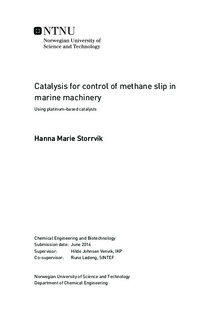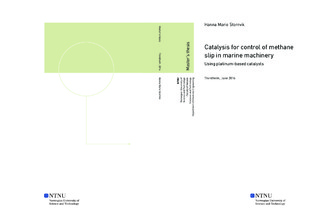| dc.description.abstract | Greenhouse gas abatement in the shipping industry has become increasingly relevant in the recent years, due to stricter laws and regulations. The use of ships running on liquid natural gas is thus growing rapidly in the shipping industry, being established as an attractive and environmentally friendly alternative to conventional ships running on bunker fuel. Ship engines operating in lean conditions have proven to be successful in maintaining high efficiency while reducing the NOx emissions due to sufficiently low temperatures. This is, however, on the expense of CH4 slip. More research is consequently needed in order to develop catalysts with enhanced low temperature activity, suitable for complete combustion of methane in exhaust gas after-treatment systems on LNG ships.
In this project, alumina-supported platinum catalysts, with metal loading of 2 wt.% and 0.2 wt.%, have been synthesized by incipient wetness impregnation, using chloroplatinic acid as a precursor of Pt. The catalysts have been characterized with some of the main characterization techniques, including N2 physisorption, volumetric chemisorption, XRD and XRF. The catalysts have furthermore been investigated for complete oxidation of methane under stoichiometric and oxygen-rich conditions with CH4 to O2 ratios of 1:2 and 1:5, respectively. Different reactant concentrations have been tested within the given stoichiometry, to investigate the feed conditions that enhance low temperature activity for the synthesized catalysts.
Semi-crystalline γ-alumina was found to be the only compound detected in XRD analyzes, where absence of a detected platinum phase was suspected to be due to finely dispersed platinum particles with small crystallite sizes. This was substantiated by chemisorption experiments, revealing high dispersion and small particle sizes for both catalysts. Chlorine containing catalysts possessed a somewhat larger surface area than a non-chlorine containing catalyst, which is proposed to have a correlation, due to possible re-dispersion of platinum when exposed to O2 at high temperatures.
The 2 wt.% catalyst exhibited better performance than the 0.2 wt.% catalyst, and a temperature of about 70-90 °C more was necessary to obtain the same level of conversion with the lowest metal loading. Stoichiometric reactant concentrations were found to enhance low temperature activity of the catalysts, in comparison to oxygen-rich conditions. Higher concentrations of PtO2 are discussed to be the cause of the inferior activity displayed in excess O2, as platinum is more likely to be oxidized to a greater extent in such conditions. The catalytic activity was furthermore found to increase with increasing methane concentration, whereas the temperature necessary to obtain complete conversion, decreased with decreasing methane concentration. The lowest temperature needed to obtain complete conversion, was observed in excess O2 with feed containing 1000 ppm CH4, which resembles application relevant conditions the most among the tested. | |

